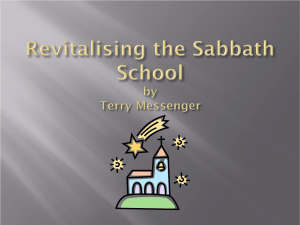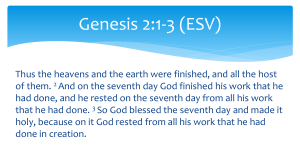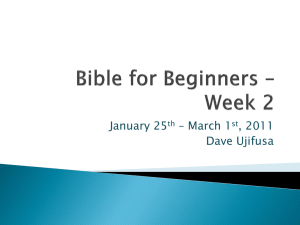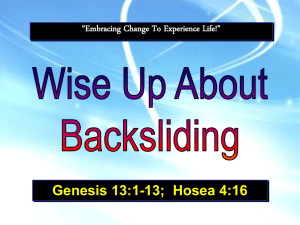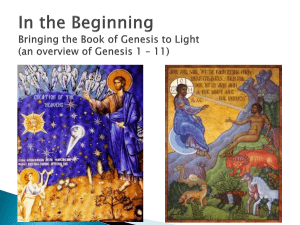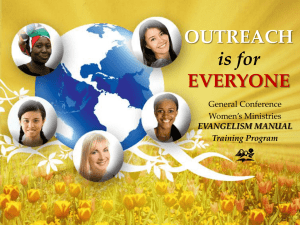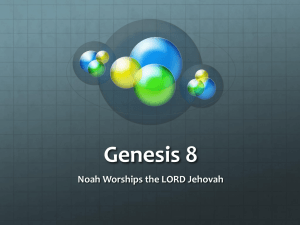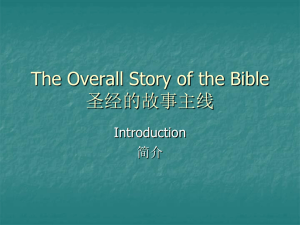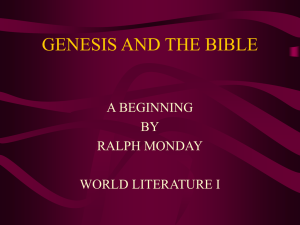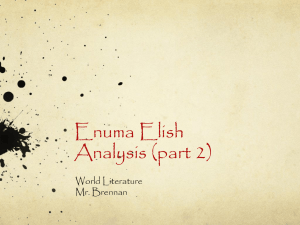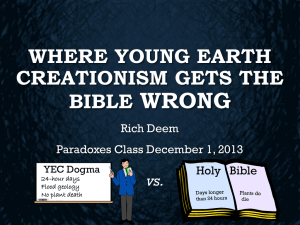PHILOSOPHY 100 (STOLZE)
advertisement
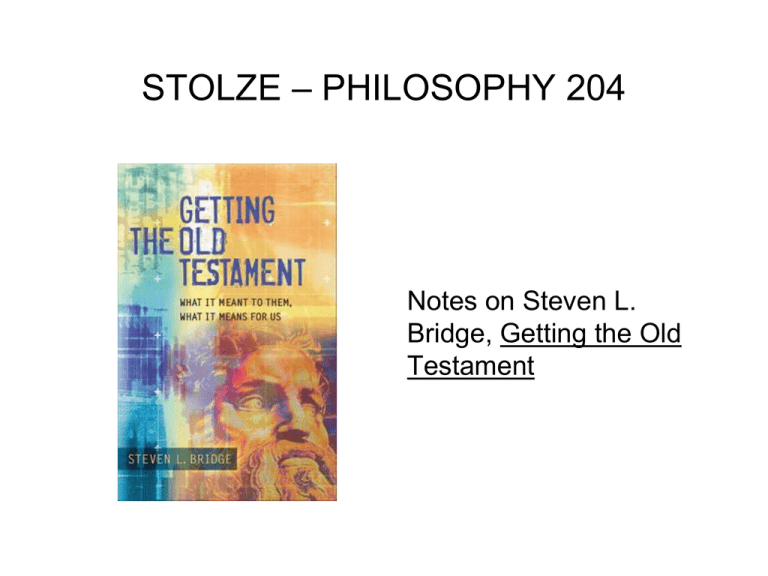
STOLZE – PHILOSOPHY 204 Notes on Steven L. Bridge, Getting the Old Testament A Key Distinction • • Bible Studies = devotional or ritual use of the Bible from the standpoint of committed faith Biblical Studies = study of the socio-historical background to, and the oral/literary formation of, the Bible from the standpoint of critical rational inquiry Another Key Distinction • • In this course we’ll do our best to take the Bible seriously. However, this does not mean that we have to read the Bible literally. Instead, it does mean reading biblical texts by situating them within their comparative historical, religious, economic, political, cultural, literary, and archeological contexts. Bridge emphasizes that how we “overhear” the Bible affects the transmission of its meanings over time. Seven Key “Backstories” of the Hebrew Bible 1. 2. 3. 4. 5. 6. 7. God has subdued chaos, just barely. (The Backstory of Creation.) God has given humans an instruction manual for life on planet Earth so they can partner with God in the management of chaos. (The Backstory of Torah) God has enacted the tough love of moral cause and effect in order to reward fidelity to the instruction manual and to support management of the chaos. (The Backstory of the Former Prophets.) God enlists prophets to mediate this dynamic partnership upon which the health of creation depends. (The backstory of the Latter Prophets.) Through praise humans release energy that augments God’s management of chaos; through lament humans report on the quality of God’s management of chaos. (The Backstory of Psalms.) Here and there, humans catch glimpses of the divine design for chaos management; living according to these insights is another expression of the partnership. (The Backstory of Wisdom.) There are times when chaos gains the upper hand and humans in partnership with God can only hope that God is able, as in the beginning, to subdue chaos. (The Backstory of Apocalyptic.) (From Gregory Mobley, The Return of the Chaos Monsters—And Other Backstories of the Bible [Grand Rapids, MI: Wm. B. Eerdmans Publishing Co., 2012], pp. xi-xii.) The Three Traditional Parts and Thirty-Nine Books of the Hebrew Bible (TANAK) • • • Torah (Genesis, Exodus. Leviticus, Numbers, Deuteronomy) Prophets (Former: Joshua, Judges, 1-2 Samuel, 1-2 Kings; Latter: Isaiah, Jeremiah, Ezekiel; The Twelve: Hosea, Joel, Amos, Obadiah, Jonah, Micah, Nahum, Habakkuk, Zephaniah, Haggai, Zechariah, Malachi) Writings (Job, Psalms, Proverbs, Ecclesiastes, Song of Songs, Ruth, Lamentations, Esther, Daniel, Ezra, Nehemiah, 1-2 Chronicles) Chapter One: The First Creation Story in Genesis • Defining the Controversy: Is the Biblical Account of Creation True? • Historical Truth: Modern vs. Ancient Approaches • The Narrative Structure of Genesis 1:1-2:4a • The Historical Context of Genesis 1:1-2:4a Comparative similarities and differences with the Babylonian Creation Story, the Enuma Elish • Models of Human Dominion/Stewardship over Nature • The Meaning of Sabbath • The Truth Claims of Genesis 1:1-2:4a The Narrative Structure of Genesis 1:1-2:4a Day One Day Four Light Bodies of Light Day Two Day Five Sea and Sky Creatures of the sea and sky Day Three Day Six Land (and plants) humans) Creatures of the land (animals and Day Seven Rest Genesis 1:1-2:4a as an Israelite Critique of, and Alternative to, the Babylonian Enuma Elish “[T]he religion that first bound ‘Israel’ contained elements not far removed from Enuma Elish. But by the time of the Exile, people had wrestled with YHWH, one another, and their neighbors for centuries. For many, Enuma Elish’s version of ‘creation’ was blasphemous. However, it was and remains one thing to criticize someone else’s worldview, and quite another to have a clear and coherent vision of one’s own. For many in Babylonian Exile, the first chapters of Genesis offered the beginning of that systematic alternative. At the heart of its stories of origins of the earth and humanity is the question: If the Babylonian story is wrong, how did things come to be? Put another way: What stories should we teach our children to keep them from being influenced by the power of Enuma Elish and the opulence and might of Babylon that, for now at least, is our home? Read from this perspective, the majestic and stately account of God’s creation ‘in the beginning’ can be heard for what it is: a counter-narrative to the Babylonian worldview. Each carefully worded detail expresses with power and beauty the ways of the true Creator. For instance, consider the contrast between the means of creating earth’s creatures. In Enuma Elish, Tiamet’s body is ripped open by the violence of her son, bringing forth the species. But in Genesis, it is God’s ‘word’ that brings things into being. But the Hebrew (‘amar) and Greek (lego) verbs for ‘to speak’ imply not simply the physical act of pronouncing words but also the deeper sense of bringing an intention into being. God’s creative word is not in reaction to anything else, as Marduk’s violence is. Creation does not arise as a response, but simply because God wills it into being” (Wes Howard-Brook, “Come Out, My People!”: God’s Call out of Empire in the Bible and Beyond [Maryknoll, NY: Orbis Books, 2010], pp. 18-19). Humans Created in the “Image” of God “Hebrew tselem generally refers to a statue or other physical representation, such as of a god or goddess. It seems likely that Genesis presents human beings serving a parallel function to Babylonian or other ‘idols.’ When you see a human being, you are seeing an ‘image’ of God.” (Wes Howard-Brook, “Come Out, My People!”: God’s Call out of Empire in the Bible and Beyond [Maryknoll, NY: Orbis Books, 2010], p. 21). The Dominion/Stewardship Model of Creation • • In her article “Common Ground: An Ecological Reading of Genesis 23” (Earth Story in Genesis, edited by Norman C. Habel and Shirley Wurst [Cleveland: The Pilgrim Press, 2000] Carol Newsom reminds us that there is a wordplay on the name for humankind in Hebrew (adam) and the name for Earth (adamah): “we share common ground with the Earth because we are common ground…so to call the creature adam is to recognize its solidarity with Earth” (p. 63). In his book The Bible and Ecology (Waco: Baylor University Press, 2010) Richard Bauckham likewise argues that “the earthiness of humans signifies a kinship with the Earth itself and with other earthly creatures, plants and animals. Human life is embedded in the physical world with all that that implies of dependence on the natural systems of life” (p. 21). An Alternative Model of Human Dominion “Does God’s mandate to humans at creation encourage us to become controllers and managers of the whole of creation on this planet? No. It ascribes to God’s gift the unique degree of power within creation that realistically our species has, and we should neither underestimate nor exaggerate that if we are to exercise it responsibly, as the mandate requires. Granted our limited place within the God-given order of creation, the power we do have is to be exercised with loving care for the rest of creation. Our right to use the Earth’s resources for human life and flourishing is strictly limited by the responsibility to conserve and by the rights of the other living creatures who share the Earth with us. A role of caring responsibility for other living creatures, our ‘dominion’, is not a role that sets us above creation but a specific role that humans have within creation. It is rightly practised only when we recognize it to be dominion over fellow-creatures” (Richard Bauckham, The Bible and Ecology, pp. 33-4). The Meaning of Sabbath The biblical scholar Walter Brueggemann has argued that God’s establishment of a day of rest or sabbath at the end of the six days of creation is an assertion that “life does not depend on our feverish activity of self-securing, but that there can be a pause in which life is given to us simply as a gift.” Brueggemann argues that the sabbath has four key aspects: • The sabbath discloses that “in contrast to the gods of Babylon, this God is not anxious about his creation but is at ease with the well-being of his rule.” • The sabbath announces that “the world is safely in God’s hands. The world will not disintegrate if we stop our efforts.” • The sabbath is “a sociological expression of a new humanity willed by God. Sabbath is the end of grasping and therefore the end of exploitation. Sabbath is a day of revolutionary equality in society. On that day all rest equally, regardless of wealth or power or need….Of course, the world is not now ordered according to the well-being and equality of sabbath rest. But the keeping of sabbath, in heaven and on earth, is a foretaste and anticipation of how the creation will be when God’s way is fully established.” • The sabbath is not just about the rest of God, but “because humankind is in the image of God, the rest of God is a promised rest for humankind. The rest is not a sleep which escapes history. It is the freedom and well-being of a new kind of history.” (From Walter Brueggemann, Genesis: A Bible Commentary for Preaching and Teaching [Philadelphia: John Knox Press, 1982], pp. 35-6.) The Truth Claims of Genesis 1:1-2:4a A Key Philosophical Question: Creation out of Chaos? or Creation out of Nothingness? Chapter Two: The Second Creation Story • • Comparative Discrepancies between the Two Creation Stories Truth in Contradiction? Bridge’s Summary of the Comparisons/Contrasts between Genesis 1 and 2 Gen 1:1-2:4b Gen 2:4b-25 Source Priestly (P) Yahwist (J) Divine name Elohim YHWH Elohim Order 1-Light 2-Waters, sky 3-Land, plants 4-Bodies of light 5-Water, sky creatures 6-Land creatures 7-Sabbath rest 1-Man 2-Plants 3-Animals 4-Woman Creative act Spoken into being Formed out of clay Truth claims a) Emphasizes God’s nature as 1-Transcendent 2-Omnipotent a) Emphasizes God’s nature as 1-Intimate 2-Personal b) Humans as the culmination of creation b) Man as the impetus for creation c) Stresses the relationship between --Humanity and God c) Stresses the relationship between 1-Humankind and the earth 2-Woman and man Chapter 3: The Great Flood • • • • • Historical Considerations Internal Contradictions Ethical/Theological Concerns The Literary Background: Ancient Near Eastern Flood Narratives The Flood Story as Satire Historical Considerations: David Montgomery on the Great Flood and Modern Geology http://www.youtube.com/watch?v=chHU5HPkxmM http://discovermagazine.com/2012/jul-aug/06-biblical-typefloods-real-absolutely-enormous/article_view?b_start:int=1&-C= Internal Contradictions • An interweaving of two literary sources: J (Yahwist) and P (Priestly) Ethical/Theological Concerns • “Why would God obliterate his own handiwork?” (p. 44) The Literary Background: Ancient Near Eastern Flood Narratives • • • “The great flood…was a fact of life for the OT authors. So how could they account for it? In the Mesopotamian accounts, the roles of creator god, destroyer god, and sympathetic god are each played by different deities. Given their monotheistic belief system, the Yahwist and Priestly authors had little choice but to subsume them all into one. Paradoxical as it might seem, then, the God who created humans would now also be bent on destroying them” (p. 49) The Gilgamesh Epic The Story of Atrahasis The Flood Story as a Satire “The story is in many ways a satire of the Sumerian Gilgamesh Epic. In that narrative, a future king went off to seek the secret of immortality. After many harrowing experiences—including power acquired by defeating the embodied forces of the natural world and a great flood—he found that he must accept life ‘as it is.’ In other words, one can’t change the world but must adapt to it. In the Genesis Flood, not only is the hero no king, but the world is utterly transformed as a result of his collaboration with the divine will and power. God makes a ‘covenant’ with Noah and ‘all flesh’ never again to cause widespread destruction by flood (9:9-17). Noah’s reaction to this new development is not narrated, but once he is on dry land, Noah plants a vineyard. What a long time he must wait for that celebratory drink of wine! He, like Cain, is described as a “man of the soil” [’adamah] (9:20). He, too, is a child of agriculture. There was indeed no going back to Eden for Noah and his descendants. From his three sons, Genesis states, ‘the whole earth was peopled’ (9:19). This contrasts starkly with ‘empire religion,’ in which peoples are pitted against one another in the ongoing battle for honor and control of resources. But in the religion of creation, all humanity is one family, creatures of one God, even outside the Garden.” (Wes Howard-Brook, “Come Out, My People!”: God’s Call out of Empire in the Bible and Beyond [Maryknoll, NY: Orbis Books, 2010], pp. 44-5).
